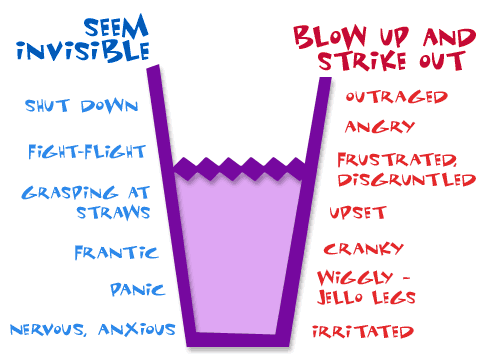Students may
- Use repetitive phrases
- Repeat the phrase spoken to him/her
- Speak almost in sentences, but omit “I”, “Me”,
“Yes”
- Answer questions or statements with unrelated ideas
- Use very literal language with symbolism missing
- Be startled and upset by unexpected or loud noises
- Respond inappropriately or aggressively to being touched
- Be hypersensitive to visual stimuli
- Prefer to be alone, play in isolation, not interact with others
- Engage in self stimulating activities
- Show little emotion that reflects empathy or affection
- Engage in repetitive motions and sounds, non-stop
|
Autism
There is a broad range of symptoms and seriousness in autism. Some youngsters
never overcome the separation between self and others. Some go on, as
Bill Gates and Temple Grandin have, setting up a model for using the gifts
rather than being weighed down by the limitations. Each student is an
individual and will need special accommodations , goals, plan |
- Focus on communications and ways to make connections.
- Structure activities and the day in highly consistent manner and maintain
that pattern.
- Let the student know before the bell rings, or when loud noises are
about to occur, when possible.
- Develop curriculum to coincide with student interest -- often singular
focus, like the ocean, space, but a fertile area to provide thematic
learning unit and activities that are motivating.
- Use highly structured, direct approach.
- Focus part of instruction on life skills and socialization.
- Involve the parents and honor things they have found useful.
- Prevent outbursts rather than using behavior mod after eruptions.
|
- Executive functioning difficulties potentially including working memory,
recall, impulsivity, self-talk that does not support socialized responses;
low tolerance of frustration;
- Noise, color, high stimulation situations tend to overload impulses
- Students have trouble comprehending what is read
- Cannot memorize isolated facts
- Have trouble organizing thought to write them or produce creative
written work
- May have difficulty listening, especially if must also hold body still
- Irritable and argumentative quite often but sporadically
- Begin but do not complete assignments or remember to go back and finish
if interrupted.
- Ability to organize is compromised, making recall of homework instructions,
due dates, material required for class, locker combos, lunch, notebooks,
elusive
- Impaired sense of time
- Low tolerance for being thwarted with quick temper, flashes of anger,
impulsivity
- Difficulty initiating work
|
ADD/ADHD
Remember, this is a very trying condition for a youngster and is probably
part of neurological impulses and ways the brain functions. It is not
a choice the student makes for the student wouldn't choose it! |
- Simple interventions are best, especially if student developed.
- Wide variety of teaching activities.
- Utilize activities in all learning styles and intelligences to support
lessons.
- Increase number of hands-on lessons.
- Offer many visual lessons.
- Reduce written work -- give evens or odds, frequent. small screening
exams
- Help student learn to self monitor· Use colored overlays, graph
paper, different colors of paper to find best.
- Provide consistent structure
- Minimize changes in classroom appearance and dangling, too colorful
over decorated "rainforests," etc.
- Coordinate "peak" meds effectiveness and crucial learning
activities.
- Give individual nudges and support throughout the day.
- Model skills for students
- Provide key points prior to the lecture and guided lecture notes so
student can follow if lecture (least effective way for most of us to
learn) is used.
- Help student make cue cards on key items s/he is likely to forget
- Use webbing and mind maps
|

